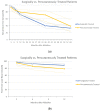Microwave Ablation for Colorectal Liver Metastases: A Systematic Review and Pooled Oncological Analyses
- PMID: 35267612
- PMCID: PMC8909068
- DOI: 10.3390/cancers14051305
Microwave Ablation for Colorectal Liver Metastases: A Systematic Review and Pooled Oncological Analyses
Abstract
(1) Background: colorectal liver metastases (CRLM) are the most common extra-lymphatic metastases in colorectal cancer; however, few patients are fit for curative surgery. Microwave ablation (MWA) showed promising outcomes in this cohort of patients. This systematic review and pooled analysis aimed to analyze the oncological results of MWA for CRLM. (2) Methods: Following PRISMA guidelines, PubMed, Scopus, EMBASE, Google Scholar, Science Direct, and the Wiley Online Library databases were searched for reports published before January 2021. We included papers assessing MWA, treating resectable CRLM with curative intention. We evaluated the reported MWA-related complications and oncological outcomes as being recurrence-free (RF), free from local recurrence (FFLR), and overall survival rates (OS). (3) Results: Twelve out of 4822 papers (395 patients) were finally included. Global RF rates at 1, 3, and 5 years were 65.1%, 44.6%, and 34.3%, respectively. Global FFLR rates at 3, 6, and 12 months were 96.3%, 89.6%, and 83.7%, respectively. Global OS at 1, 3, and 5 years were 86.7%, 59.6%, and 44.8%, respectively. A better FFLR was reached using the MWA surgical approach at 3, 6, and 12 months, with reported rates of 97.1%, 92.7%, and 88.6%, respectively. (4) Conclusions: Surgical MWA treatment for CRLM smaller than 3 cm is a safe and valid option. This approach can be safely included for selected patients in the curative intent approaches to treating CRLM.
Keywords: colorectal liver metastasis; liver resection; microwave ablation.
Conflict of interest statement
The authors declare that they have no known competing financial interests or personal relationships that could have appeared to influence the work reported in this paper.
Figures





Similar articles
-
Systematic review and meta-analysis of local ablative therapies for resectable colorectal liver metastases.Eur J Surg Oncol. 2020 May;46(5):772-781. doi: 10.1016/j.ejso.2019.12.003. Epub 2019 Dec 4. Eur J Surg Oncol. 2020. PMID: 31862133
-
Unresectable Intermediate-Size (3-5 cm) Colorectal Liver Metastases: Stereotactic Ablative Body Radiotherapy Versus Microwave Ablation (COLLISION-XL): Protocol of a Phase II/III Multicentre Randomized Controlled Trial.Cardiovasc Intervent Radiol. 2023 Aug;46(8):1076-1085. doi: 10.1007/s00270-023-03498-8. Epub 2023 Jul 10. Cardiovasc Intervent Radiol. 2023. PMID: 37430016 Free PMC article.
-
Colorectal liver metastases: surgery versus thermal ablation (COLLISION) - a phase III single-blind prospective randomized controlled trial.BMC Cancer. 2018 Aug 15;18(1):821. doi: 10.1186/s12885-018-4716-8. BMC Cancer. 2018. PMID: 30111304 Free PMC article. Clinical Trial.
-
Role of thermal ablation in the management of colorectal liver metastasis.Hepatobiliary Surg Nutr. 2020 Feb;9(1):49-58. doi: 10.21037/hbsn.2019.06.08. Hepatobiliary Surg Nutr. 2020. PMID: 32140478 Free PMC article. Review.
-
Surgical microwave ablation for multifocal non-resectable liver metastases: a single institution experience treating five or more liver lesions.J Gastrointest Oncol. 2021 Dec;12(6):2960-2965. doi: 10.21037/jgo-21-203. J Gastrointest Oncol. 2021. PMID: 35070422 Free PMC article.
Cited by
-
How Can We Improve the Survival of Patients with Colorectal Liver Metastases Using Thermal Ablation?Cancers (Basel). 2025 Jan 9;17(2):199. doi: 10.3390/cancers17020199. Cancers (Basel). 2025. PMID: 39857982 Free PMC article.
-
Surgery combined with intra-operative microwaves ablation for the management of colorectal cancer liver metastasis: A case-matched analysis and evaluation of recurrences.Front Oncol. 2022 Oct 14;12:1023301. doi: 10.3389/fonc.2022.1023301. eCollection 2022. Front Oncol. 2022. PMID: 36505851 Free PMC article.
-
Prediction of Local Tumor Progression After Microwave Ablation in Colorectal Carcinoma Liver Metastases Patients by MRI Radiomics and Clinical Characteristics-Based Combined Model: Preliminary Results.Cardiovasc Intervent Radiol. 2023 Jun;46(6):713-725. doi: 10.1007/s00270-023-03454-6. Epub 2023 May 8. Cardiovasc Intervent Radiol. 2023. PMID: 37156944
-
Decision-Making for Ablation of Colorectal Liver Oligometastases Patients: A 10-Year Retrospective Study of Survival Outcomes Based on Right-Versus Left-Sided Primary Tumor Location.Cancer Control. 2025 Jan-Dec;32:10732748251324627. doi: 10.1177/10732748251324627. Epub 2025 Mar 14. Cancer Control. 2025. PMID: 40085923 Free PMC article.
-
Ablative Therapy in Non-HCC Liver Malignancy.Cancers (Basel). 2023 Feb 14;15(4):1200. doi: 10.3390/cancers15041200. Cancers (Basel). 2023. PMID: 36831543 Free PMC article. Review.
References
Publication types
LinkOut - more resources
Full Text Sources

